I think I'm done with Sacred Sites tourism games. Back over to science, with some plans I've had in mind for a while. First, a brief report of a game that didn't work out.
That game was Poland, and the idea was to use Poland's free policies to fill both Commerce and Rationalism. These were the plans and lessons learned:
- I planned to bring Mercantilism forward into the expansion phase. Poland can burst three policies deep into a medieval tree very fast: finish Tradition one sooner with the classical free policy, then apply the medieval free policy, plus the Oracle. The one big highly leverageable policy three-deep into a medieval tree is Mercantilism. This worked in that I did get Mercantilism early (turn 85), but it didn't really make much difference in expansion speed, I only bought one settler and a couple workers with it.
- I had hoped to accelerate universities via Mercantilism, but that didn't work out, I only got enough gold to buy two before the cities just built them normally.
- Bringing Landsknechts forward also looked good (buy a cheap unit that can clear barb camps all by itself), but never really panned out. You can kill camps near home with whatever units, and it takes too long to walk far across the map for anything else.
- The later game idea was to stack up the Commerce-Rationalism synergy on trading posts, getting both the gold and beaker additions. The problem was that working the trading posts was a drag and never got the cities up to good sizes. Poland's beaker production was consistently behind my previous Shoshone science game, and the difference was city size and also the non-scientist specialists for the Secularism beakers.
- I used all the trade route slots as sea routes from a coastal capital, for gold to feed into Mercantilism. But that didn't really get anywhere either. Gold routes just aren't ever good enough compared to food and production. They don't produce nearly enough early on. They do ramp up around the renaissance era after harbors, I got to 250/turn income, but by then that's too late to do anything towards speeding the win date.
- I wanted a fast East India Company to see how that would work, but that plan got absolutely nowhere. Because markets are absoutely terrible builds in BNW without the killed river gold yield. So East India was never enabled until way late.
That game came in about 12 turns behind the previous Shoshone game, bad enough that I didn't bother finishing the report and started a new gameplan instead.
As I keep saying, speed for a science victory is determined by accelerating through the early game up to universities. Once that's set, the timeline from then until the end of the game is basically incompressible, limited by Great Scientist points and therefore by scientist slots.
What civ is good at early acceleration? The Shoshone. And I want to give them another shot. I think that choose-your-own-ruin ability is significantly more exploitable than I really managed before. In particular, that game never went for technologies. But if I want to speed up the early game to get to universities faster, perhaps the way to do it is push technology ruins hard to fill up the ancient era as fast as possible with as many freebies as possible.
And here's another adjustment to make: Huge map. I've always used Large maps for speed runs. But that was a holdover from Gods & Kings. There are two downsides to a huge map. One is being slower to find contacts to sell your luxuries, but that matters much less in BNW with cash sales nerfed without friendships. The other is that your neighbors tend to be too far to receive religious pressure, which was a must when I was relying on pressure snowballing for Ceremonial Burial happy, but with that nerfed, it doesn't really matter if religion spreads slower. And also I've learned that trick to hold your own cities at size 1 until they convert. So it's OK to go with a huge map.
Also, a huge map applies a lower tech cost penalty per city. It's 5% per city on standard size, but only 2% on huge. So it's fine to settle lots of extra cities for more Great Scientists, which cut off 8 turns each regardless of map size or tech cost.
But finally, of course, a huge map means more ruins to find. Who wants a massive supply of ruins? The Shoshone and their pathfinders, of course. Also, I learned how those ruins work. The options that are off the menu each time are your previous two choices. Elapsed time doesn't matter, older choices don't matter, only your two previous picks. What this means is that you can loop through and repeat exactly three choices. And it just so turns out there's exactly three options that repeatably accelerate the snowballing growth curve: tech, population, and gold.
Once again, this report is of a second attempt at a game plan. I played one Shoshone map opening about 100 turns in, and saw improvements to make to go faster. Things that I did wrong in that game:
- Wrong focus with the ruins. I took tech as the top priority whenever available, giving second shrift to population and gold. This was incorrect. I had hoped to burst up to Education quickly with lots of technologies, but then I discovered that only ancient era techs can be popped from ruins, but classical and later ones can't. So the limit on the beaker value of a ruin is that ~80 for techs in the second column, which won't get you to Education any meaningfully faster.
- Not enough military. Several cities had delays of 5+ turns in founding thanks to barbarians in the way. The first build order of cities #2 and #3 needs to be a unit!
- Not enough workers. I was out to something like seven cities with three workers, working an embarrassingly large number of raw tiles. The second build order of cities #2 and #3 needs to be a worker, ahead of granaries. Workers are also why you need to prioritize gold from ruins.
- Didn't deliberately aim for the starvation-settler loophole (this was the game I hinted in the RB thread) and caught on to it slightly late. And didn't really have enough hills for it anyway. I had two, and bought two more, which still wasn't enough and also delayed buying workers. You need a start where the capital can naturally acquire 6+ hills.
- Not quite enough land on that map. I had nine cities by turn 72, but ran out of room against my neighbors and still wanted more.
Enough wall of text, on with the game.
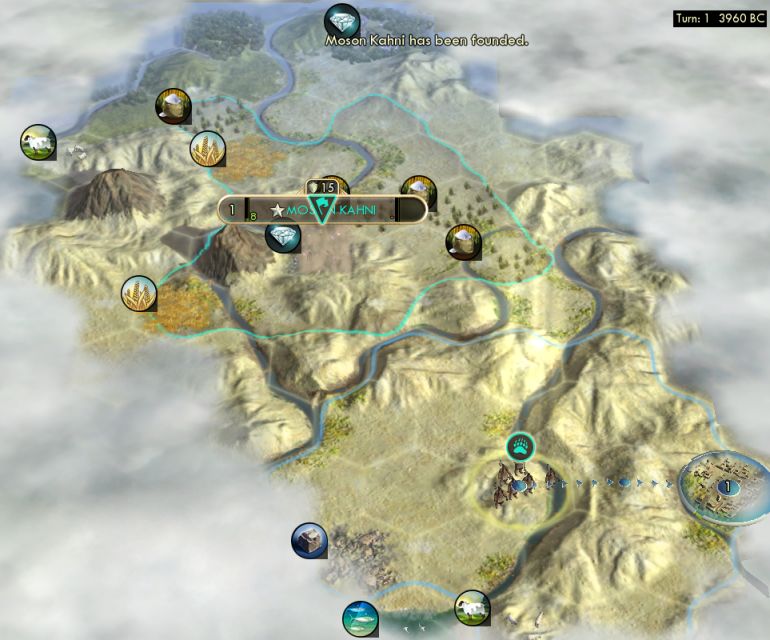
That looks promising. It's even next to a mountain, and the observatory does still matter for the second half of the game. Big question is whether we can get enough hills to take advantage of the starvation settler trick. Notice that not a single tile among the free eight pulled in a hill! But:

Nice indecision there, tile picker. But it's showing 6 out of 8 possible choices are hills, which should be good enough. In fact I would get lucky and it would take hills for all of the first five choices. This highlights how only the Shoshone can do this correctly thanks to the tile picker stubbornly hating hills: any other civ would get no hills until after like 10 tiles and 100 turns.
Set research to Mining, to sell the gems under the city. Then Pottery -> Calendar for the sugar, then a few more basics and on up to Petra.
Anyway, on to the ruins. To convey the full effect of the game plan, I'm going to show and chronicle every single one of them.
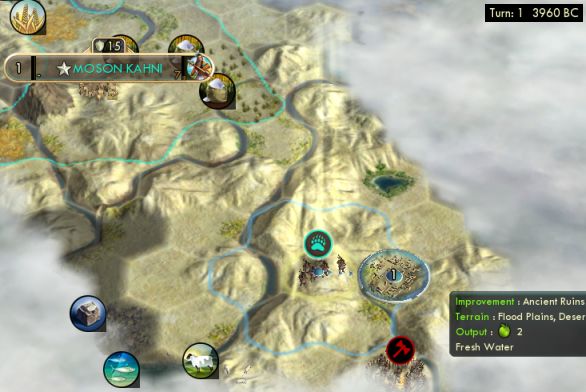
There's one available here right on turn one. The right priority order is population > gold > tech, plus a few diversions for culture and faith. The idea is to keep population and gold on that tight loop of exactly every three ruins picks, using the third slot for technologies sometimes but also for other picks when necessary.
So here on turn one, the pick was population. Note that this doesn't exactly help the city build pathfinders. The first citizen would work a hill, but the second could only go on wheat or he'd starve. But I would micromanage that into eking out some more hammers anyway; the wheat would produce +1 food surplus and so every third turn I could burn it and run -2 food on a hill instead. This is correct: spend that food via shortage, it means nothing at this capital, it would sit unused, the city would never accumulate enough to catch up to the inflating size of the food box. This city would grow exclusively on ruins until after Petra.
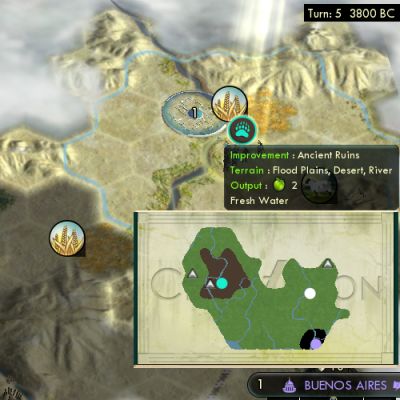 t5, this is the right time for culture for the Tradition opener, even if it skips ahead one notch on the planned pop > gold > tech/other schedule.
t5, this is the right time for culture for the Tradition opener, even if it skips ahead one notch on the planned pop > gold > tech/other schedule.
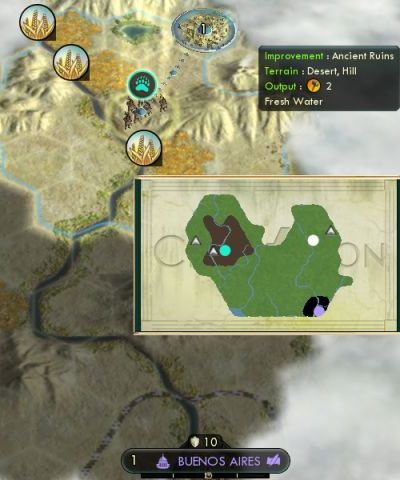 t6 found another ruin almost right away, so it's time for gold, we got 55.
t6 found another ruin almost right away, so it's time for gold, we got 55.
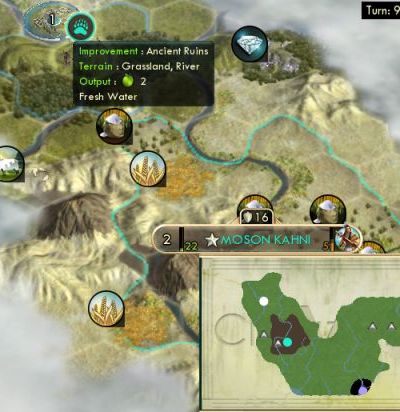 t9 back to population. And now at size 3, I would always work one wheat, and micromanage from the second wheat onto a hill every 2/3 turns instead of every 1/3.
t9 back to population. And now at size 3, I would always work one wheat, and micromanage from the second wheat onto a hill every 2/3 turns instead of every 1/3.
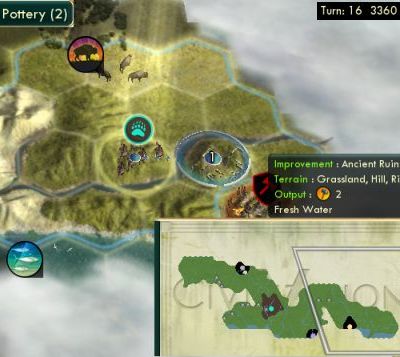 t16 population and gold aren't available, so we fall back to the last of the three good options which is tech. And it was Bronze Working! Popping this for free helps quite a bit, revealing iron to sell, ideally at the capital (didn't happen here) or with the first settler.
t16 population and gold aren't available, so we fall back to the last of the three good options which is tech. And it was Bronze Working! Popping this for free helps quite a bit, revealing iron to sell, ideally at the capital (didn't happen here) or with the first settler.
Speaking of sales, presently on t17 is when I sold the gems, for 4gpt which isn't full value but is about as much as you can expect to get this early.
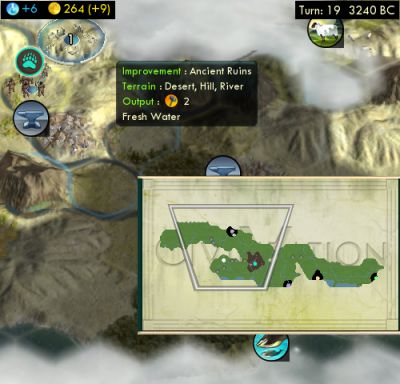 t19 and we pick gold, getting the max 100! And if you know your math with that treasury, you can add up that that's enough to buy the worker.
t19 and we pick gold, getting the max 100! And if you know your math with that treasury, you can add up that that's enough to buy the worker.
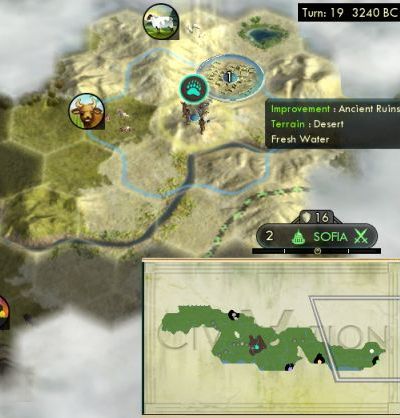 Found another ruin on that same t19, and now population (size 4) was an eligible choice. This proves that the available options don't depend on elapsed time or turns, only your previous picks.
Found another ruin on that same t19, and now population (size 4) was an eligible choice. This proves that the available options don't depend on elapsed time or turns, only your previous picks.
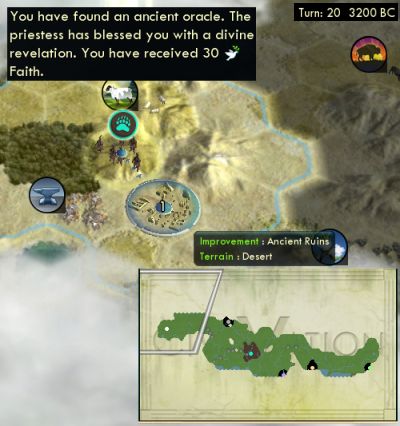 Found a third ruin on that same turn 19, but deliberately left it to turn 20. Because that's when popping faith becomes legal. This pick was scheduled for a tech, but that's the best slot to skip to pick up faith instead. We founded our pantheon this way, entirely skipping the shrine.
Found a third ruin on that same turn 19, but deliberately left it to turn 20. Because that's when popping faith becomes legal. This pick was scheduled for a tech, but that's the best slot to skip to pick up faith instead. We founded our pantheon this way, entirely skipping the shrine.
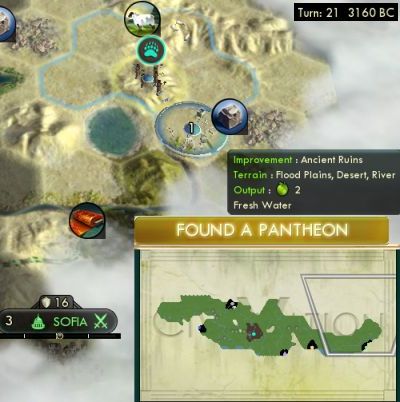 t21 a routine pick of gold (75). This is my original starting pathfinder, who's been super lucky, that's now six total for him.
t21 a routine pick of gold (75). This is my original starting pathfinder, who's been super lucky, that's now six total for him.
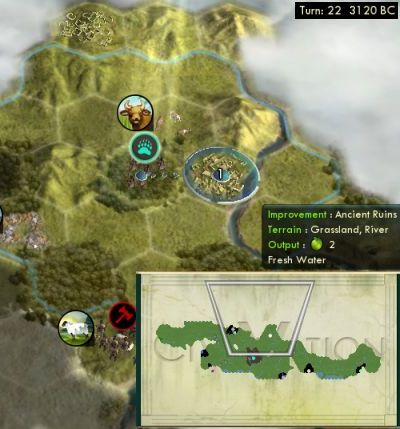 t22 population to size 5, and look at a second ruin right there for the new guy, nice.
t22 population to size 5, and look at a second ruin right there for the new guy, nice.
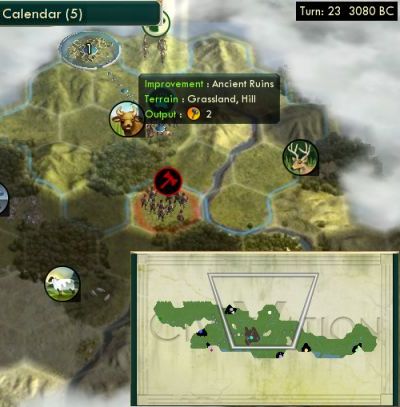 And then he snagged it just ahead of an Ottoman scout! This happened thanks to the micromanaging between wheat and hills early on -- squeezed out this pathfinder the one turn sooner that he needed to pull this. Since the past two picks were gold and pop, this had to be a tech. I had to hope it wouldn't waste the half research into Calendar, but it didn't, we got Animal Husbandry.
And then he snagged it just ahead of an Ottoman scout! This happened thanks to the micromanaging between wheat and hills early on -- squeezed out this pathfinder the one turn sooner that he needed to pull this. Since the past two picks were gold and pop, this had to be a tech. I had to hope it wouldn't waste the half research into Calendar, but it didn't, we got Animal Husbandry.
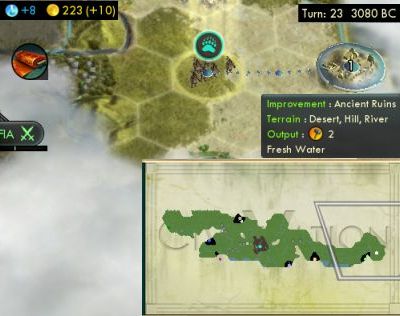 t23 another gold grab (80) by the original pathfinder. With it we bought the second worker on t24.
t23 another gold grab (80) by the original pathfinder. With it we bought the second worker on t24.
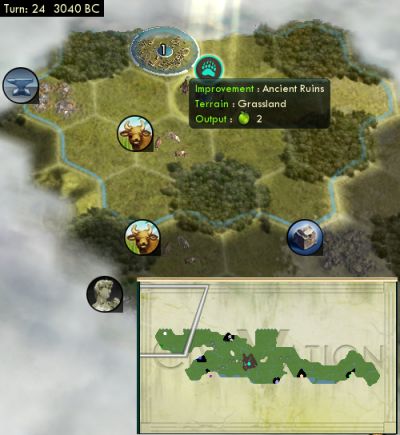 t24 population to size 6. This has still stayed strictly on schedule, population exactly every three ruins since the very first one.
t24 population to size 6. This has still stayed strictly on schedule, population exactly every three ruins since the very first one.
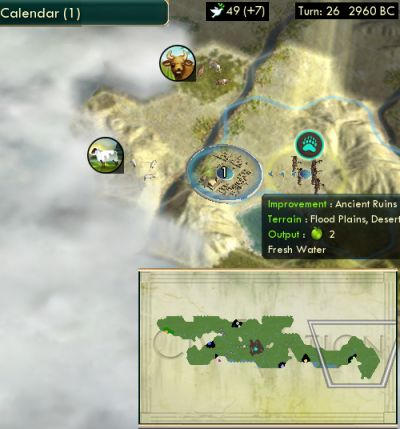 t26, the cycle says tech. But Calendar is just one turn away (risking wasting that research) and there isn't any other big priority need on the tech tree. So this is a great time to squeeze in a faith ruin, the +60 towards the great prophet.
t26, the cycle says tech. But Calendar is just one turn away (risking wasting that research) and there isn't any other big priority need on the tech tree. So this is a great time to squeeze in a faith ruin, the +60 towards the great prophet.
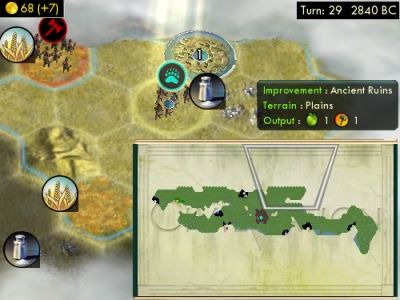 t29, gold for 90.
t29, gold for 90.
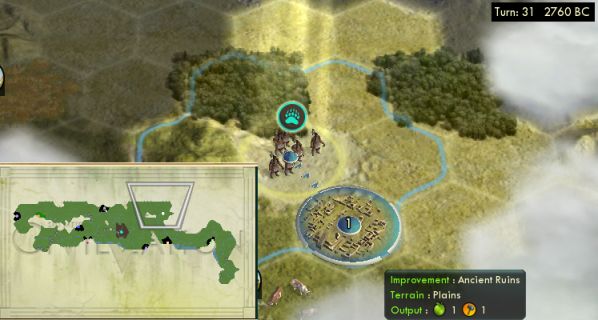 t31 pop to size 7. Although at the moment there wasn't an available hill for the 7th pop to work, but a 3g sugar isn't bad, and the city would expand to another hill shortly after this.
t31 pop to size 7. Although at the moment there wasn't an available hill for the 7th pop to work, but a 3g sugar isn't bad, and the city would expand to another hill shortly after this.
That was 16 ruins in 31 turns. Exactly what we set out to do. Paid off 240 virtual food, 400 gold, 20 culture, 90 faith, 130 beakers. But now it was like we quantum-tunneled into a universe without any more. They just abruptly disappeared and we went on and on and on without finding any more.

Take a look at the previous minimap and this one from 40 turns later. That journey all the way down the left edge of the map yielded no more ruins, as did both treks around the rim of the inland sea. And the pathfinder in the top-right got immensely delayed by walking around Ottoman territory and then by many clumps of barbarians. Not that I'm complaining, I got plenty of my share, but just relating how things worked out.
I also show this to demonstrate the general macroscopic layout of exploring on an Inland Sea map. I always do it in four grooves: two units in each direction around the inland sea, in the innermost and outermost walking lanes. Ruins last longest on the edges, as AI units following a random walk will tend towards the middle of the Inland Sea land band. City-states also cluster towards these edges, as the civilizations first occupy the favorable spots in the center lane. So running the four grooves finds the most of all of those. There isn't need for more explorers than that; even on a huge map there's not enough space left between the grooves to justify another.
Alright, enough about ruins. Now back to actual Civilizationing.
Or, at least a brutal loophole exploit that somewhat resembles Civilizationing. It's time to literally break the game.
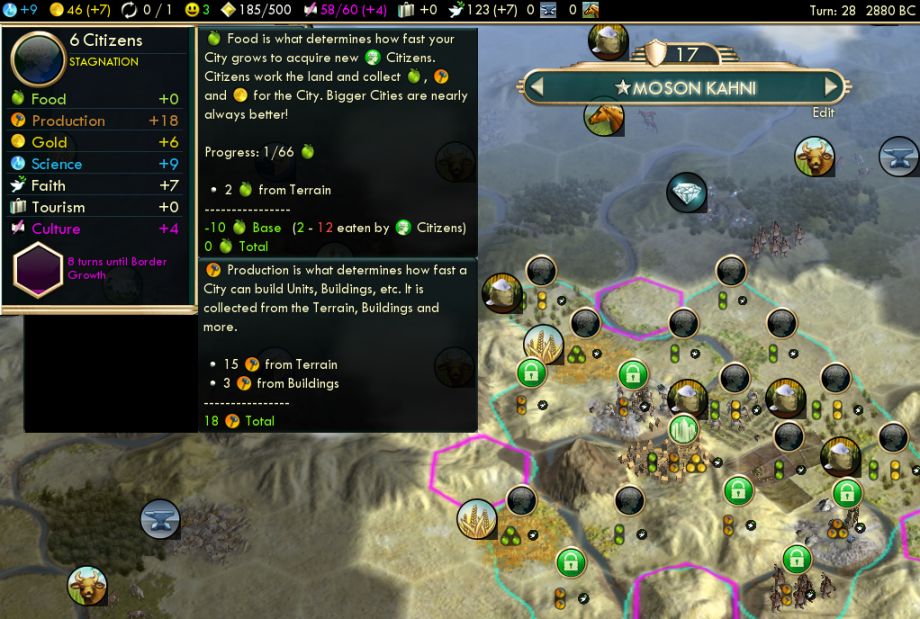
I crafted this start and gameplan to take advantage of the "starvation settlers" trick mentioned before. That is -10 food shortage just vanishing into unaccountability, as my city works all hills to put hammers into settlers instead. Even though I'm playing Tradition, this is just about equivalent to sneaking in my own implementation of Collective Rule anyway.
Couldn't you go for both Collective Rule and this trick for even more crazy explosive settler production? Yes, but together those make diminishing returns, not augmenting. On anything that you can only produce a limited amount of, it becomes self-defeating to stack up multiple bonuses. You get less use of both bonuses because the item gets completed faster, so you put in less base input to get multiplied. It's the same principle as stacking up Industrious on top of a +100% wonder resource in Civ 4. It feels good, but actually each bonus works to shorten the other's party, and you actually get less usage in total. It's even ultimately the same principle as self-defeating banks in Civ 4, where you can only produce a limited amount of money (equal to your costs; all economy beyond costs goes into beakers.) Just as a bank reduces its own baseline input of gold, multiple settler bonuses reduce their own baseline input of hammers.
Anyway, so the build order was pathfinder - pathfinder - pathfinder - pathfinder - pathfinder - settler - settler - settler - settler - settler - settler - settler - settler - settler. Yes, five pathfinders then nine settlers. Nothing else. Shrine and granary and monument weren't necessary, workers would be bought, more units would come from the other cities.
The five pathfinders were three to explore (plus the starting one), and then two for defense and escort against barbarians. I found this out in my previous aborted game: one unit here isn't enough, you need two, one to defend your workers and one to escort a settler. Just as they're doing in this picture:

So here's city two, in a nice cozy rich location. The treasury is almost up to 310 to buy my third worker to serve this city. And an interesting job by the tile picker. It was smart enough to get that one plains hill to the south, but dumb enough not to get the iron. But that was the first next tile it acquired, and I got that sold in reasonable time on t51.
You can also see the faith counter at 200, and the prophet then spawned on turn 41. Tithe and Pagodas. I relearned how good Pagodas are in the Sacred Sites games; time to put them to use here. And I did keep Te-Moak at size 1 until it converted to the religion. This felt like wasted opportunity as it fell behind a couple sizes on growth, but I think it was worthwhile in the end by cascading the pressure onto all the other cities that much more quickly.
Tech order: Mining - Pottery - Calendar (sugar) - Archery (mostly to get the cheap tech out of the way for ruins popping) - Sailing (a whale luxury) - Wheel and then straight on up to Currency for Petra.
In the diplomacy department, I got friendships from Gandhi (doesn't he always?), Rammy of Siam, and Portugal. I still have no idea what causes these, just seems random, but you'll usually be lucky enough to get a couple friends to sell resources to.
So Moson Kahni just grinded out settlers. Moving ahead, here's an overview.
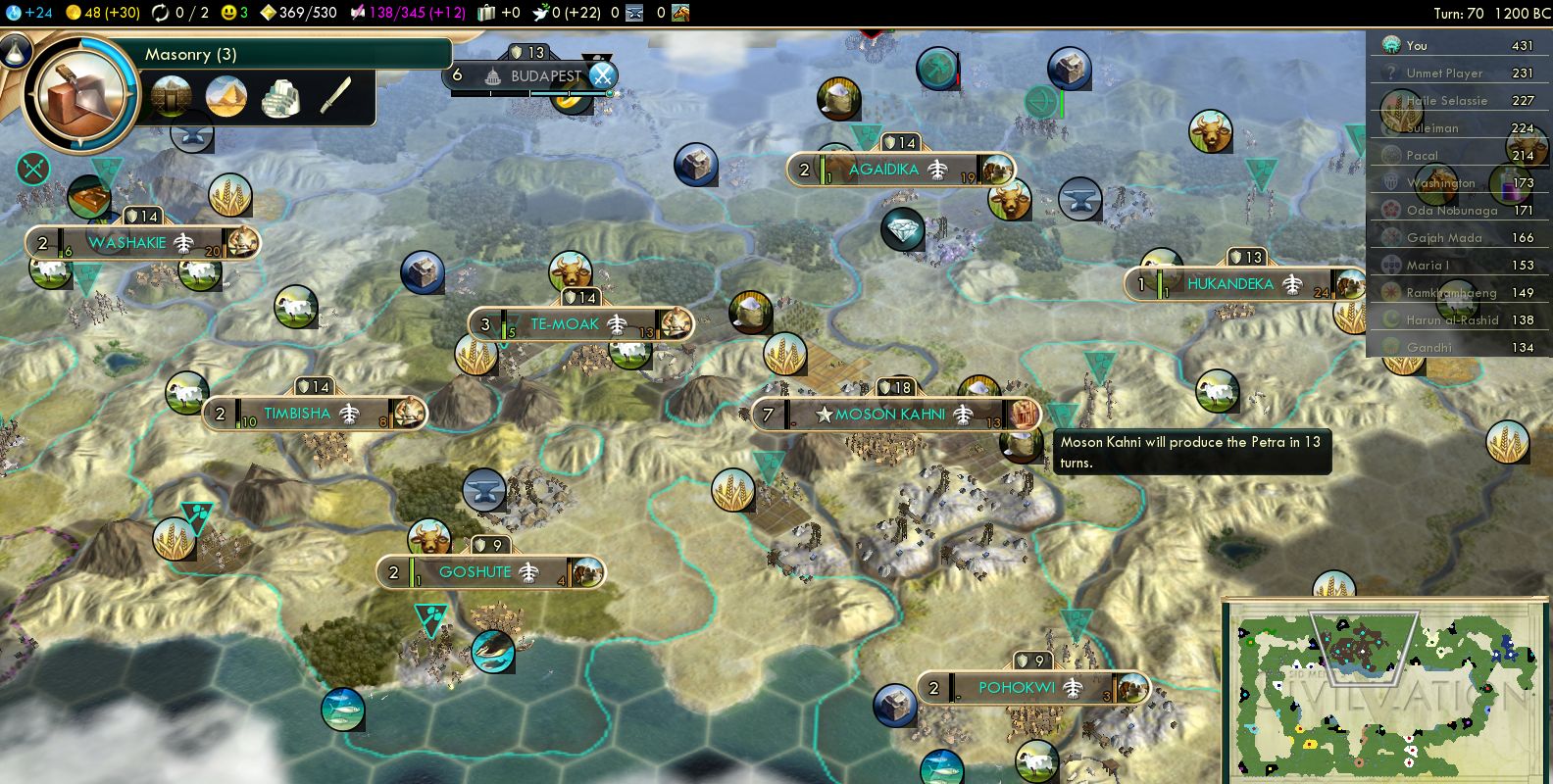
By turn 70, that's eight cities and two settlers. We outraced even mighty Spain with all the ruins population and starvation settlers.
Currency is just finished in this picture, with the capital starting Petra. I would buy one more settler to make a total of 11 cities; starvation settlers are great but still not worth delaying Petra. (And buying that settler closer to his destination saved 8 turns of travel time.)
 The picture is also right after the enhancement Great Prophet, that's why the faith counter is at zero. Standard stuff here. I just want to mention picking Tengriism. Unfortunately for historicity, there isn't any Native American religion among the names and icons in the game. All the pre-Columbian civs have to pick something that doesn't really belong to them. Tengriism and its sky and earth spirits seem to at least vaguely resemble Native American spirituality so it's the best the Shoshone can do.
The picture is also right after the enhancement Great Prophet, that's why the faith counter is at zero. Standard stuff here. I just want to mention picking Tengriism. Unfortunately for historicity, there isn't any Native American religion among the names and icons in the game. All the pre-Columbian civs have to pick something that doesn't really belong to them. Tengriism and its sky and earth spirits seem to at least vaguely resemble Native American spirituality so it's the best the Shoshone can do.
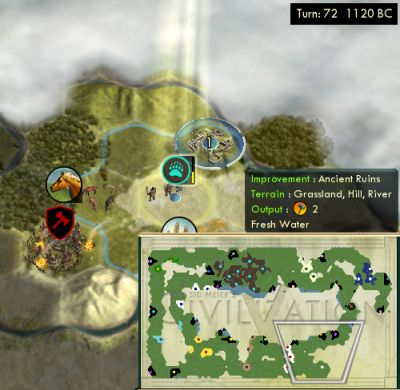 Hey, way late down in this remote corner, 40 turns after the last one, we find another ruin. Off the table were population and gold (picked "recently") and faith (which can't occur after you get your first prophet). So I took a tech, which got me all of one stinkin turn on Masonry.
Hey, way late down in this remote corner, 40 turns after the last one, we find another ruin. Off the table were population and gold (picked "recently") and faith (which can't occur after you get your first prophet). So I took a tech, which got me all of one stinkin turn on Masonry.
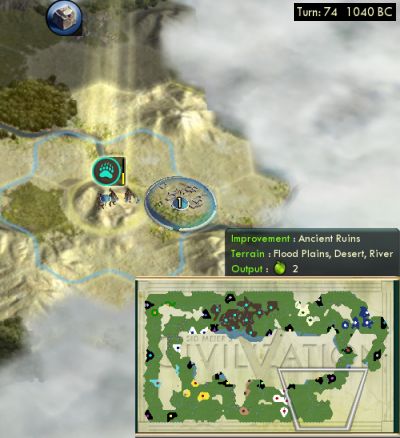 Hey, there's another. Now gold was available.
Hey, there's another. Now gold was available.
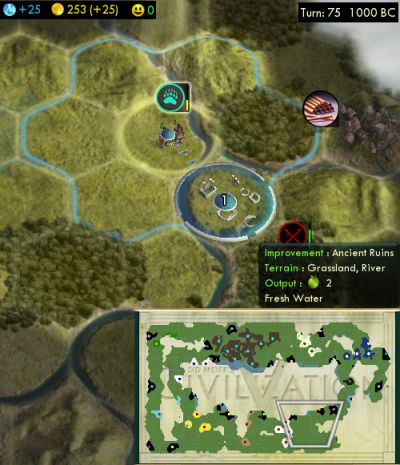 More, from a second pathfinder now reaching this southeast corner. Population is now pickable, but now I didn't want it. It wouldn't go to the capital, but just a size 1 new city, worth very little food. And also I'm slammed right up at the happy cap and can't take another citizen. So I actually took a unit upgrade, to go after barb camps.
More, from a second pathfinder now reaching this southeast corner. Population is now pickable, but now I didn't want it. It wouldn't go to the capital, but just a size 1 new city, worth very little food. And also I'm slammed right up at the happy cap and can't take another citizen. So I actually took a unit upgrade, to go after barb camps.
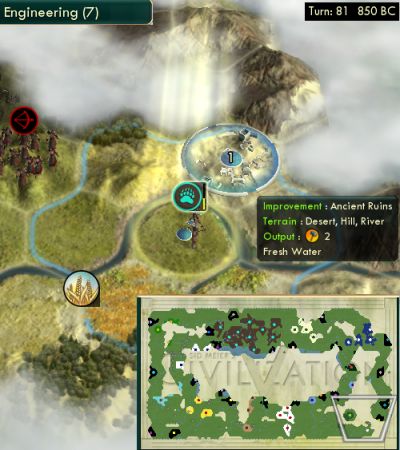 This is a great time to pick a tech. I correctly knew for certain it would be Trapping at full value, since that was the last and only ancient tech remaining.
This is a great time to pick a tech. I correctly knew for certain it would be Trapping at full value, since that was the last and only ancient tech remaining.
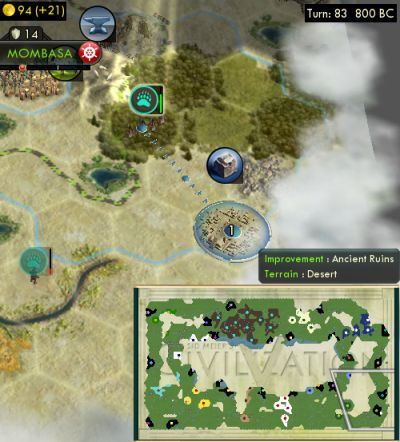 What the heck is going on here? This godforsaken remote wilderness in the corner... I feel like Hansel following his trail of breadcrumbs into the forest to his doom. Anyway, this one yielded more gold (a lowball 50.)
What the heck is going on here? This godforsaken remote wilderness in the corner... I feel like Hansel following his trail of breadcrumbs into the forest to his doom. Anyway, this one yielded more gold (a lowball 50.)
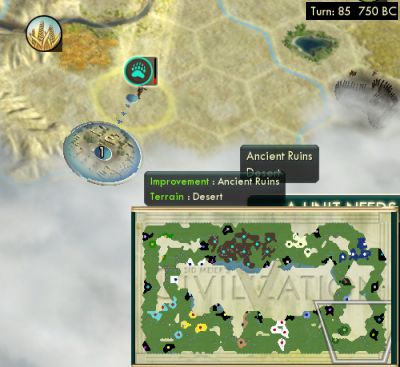 Holy crap, yet one more. I had now found several city-states in the area wanting barb camp clears, so took another unit upgrade to composite bow.
Holy crap, yet one more. I had now found several city-states in the area wanting barb camp clears, so took another unit upgrade to composite bow.
Back to building at home. Petra came in easily. Could I then get the Hanging Gardens? Check this out.
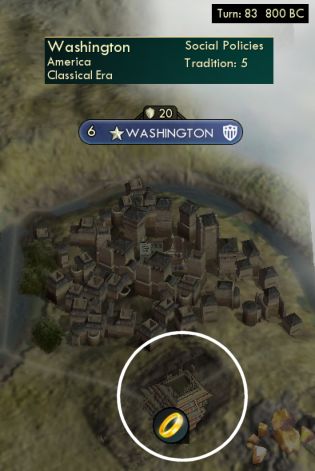
America was the only civ on the whole map who went Tradition, so my only potential competition for the HG. What wonder is that they're building? It looks like the Pyramids, but can't be that since he's not in Liberty. It looks like Chichen Itza, but he is not in the medieval era to have that tech. But it didn't look like the Hanging Gardens either. I couldn't figure out what this was, but decided to go for HG anyway. Turned out it was Terracotta Army, and I got the HG uncontested.
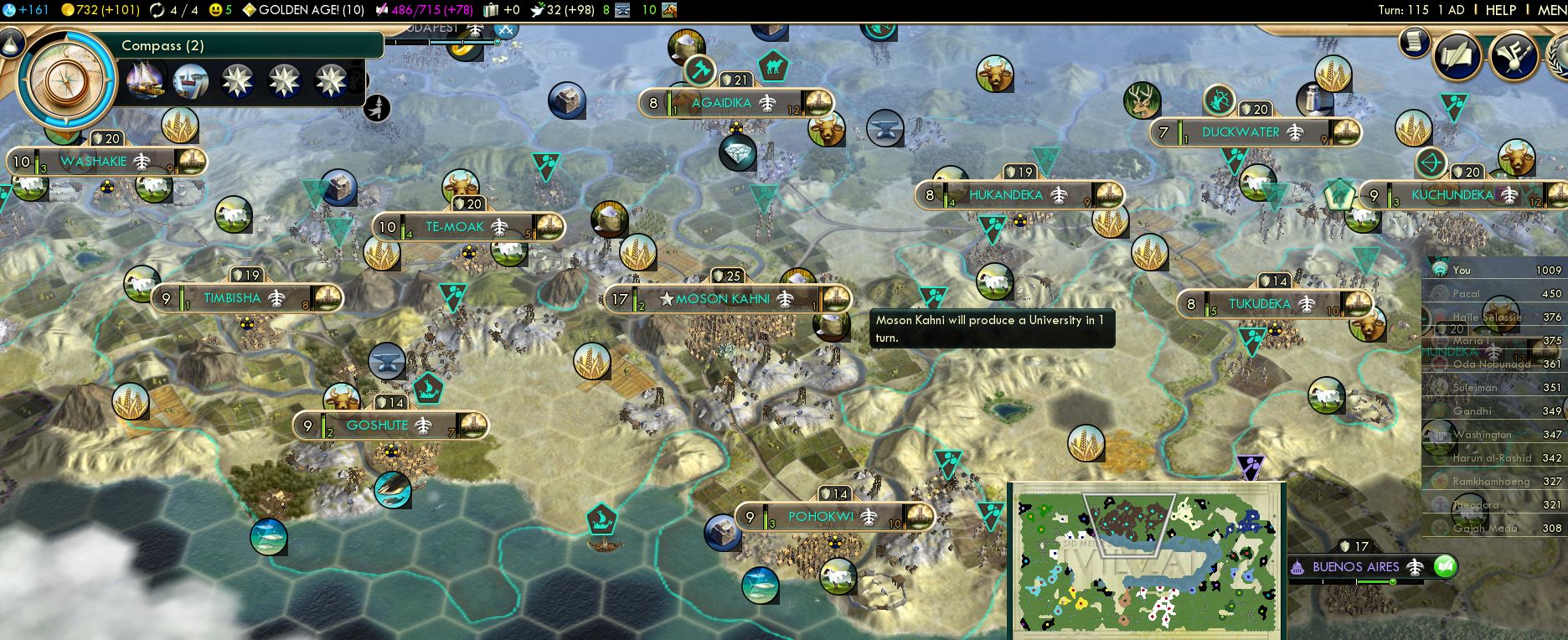
Here's the traditional 1 AD overview. Education has just come in, and there's all 11 universities being built. But I have a lot more to say here.
This felt like the most solid game of Civ 5 I ever played. It felt like my previous science games had been skimping too thin on early development, sacrificing everything just to get those universities quickly. They would literally go library - university upon founding, getting the scientists going ASAP at the cost of everything else. Even if that meant languishing at size 4 working the two scientists and food to feed them and literally no hammers to even bootstrap with a granary.
But look how strong these cities are. Everything is at size 8 in BC years. Plenty of worker support. 104 population at the calendar change. That's like triple a normal game and double my ICS bests. Compare to 28 for Egypt, 35 for Byzantium, about 60 for Brazil with El Dorado, and even Spain's acceleration came to around 70 (extrapolating from winning the game before 1 AD.)
How did we get so far ahead?
I tend to think of Civ openings in "cycles". That's a time span, maybe 20 turns early and decreasing later, during which all the cities generally build the same building. Cities that finish a building early would have the time to fill in a unit. Cities that lag behind need more worker attention and might get their next building bought. The number of cycles of progress is roughly how many buildings are complete in all of the cities. This same principle existed in Civs 4 and 3 as well, although I never really put a name to the thought until now.
It felt like the Shoshone in this game accelerated by as much as four cycles over any other game I've played. One, the last cities got founded a good 20 turns sooner thanks to the starvation-settler trick. Two, the land-grab ability meant we could skip monuments. Three, we skipped colosseums, thanks to happy from pagodas and city-states. And four, aqueducts.
In a major adjustment from my past game plans, I went for Engineering before Education. I never do this because I'm always fixated on those critical scientist slots. But I also always feel like putting off the aqueducts is wrong too. 40% food is still the biggest multiplier of any kind to anything in Civ 5. It feels like something's missing when those aqueducts have to be put off for so long until after universities, but then then it feels like they come too late to really matter. And when Tradition supplies four of them, it never feels worth chasing Engineering to fill in the rest.
But here, I did this right. I had seven cities beyond Tradition's four, and pushed hard on aqueducting them. It made a huge difference to have the aqueducts operating while building the universities. They would get each city an extra two or three sizes, exactly what they would need to populate the scientist slots without slowing down.
So the build order, following the cycle model, was granary - library - aqueduct - university. Cities that got their granaries done early or had Tradition aqueducts also squeezed in some other stuff like cargo ships and the writers' guild. I also got in several monuments and some watermills right before the universities as well. I bought mostly workers, but then one aqueduct for the newest city that needed to catch up, and one university for the one city that wasn't on freshwater (Duckwater, ironically enough) to get its scientists running sooner to make up for lacking a Garden.
I'm out to 11 cities. That's a lot for a science game, but they were all good sites pulling in lots of resources and desert. Kuchundeka in the east was the last site, but it was sooo good with eight resources and a mountain. I always say that the right wideness for a science game is any city that can produce a Great Scientist before the end. 11 cities is a tall order but I do believe I can make that happen for every one of them, more in a bit.
Happiness crunched hard. I had to fastidiously avoid most city growth for several turns, from about t80 to 90. But then it recovered remarkably well. Pagodas were big; I actually had all 11 by 1 AD for 22 critical happiness. I bought several luxuries from AI civs. And then I also got great luck on city-state quests. All the usual stuff: a few camp clears (by those ruins-upgraded Pathfinders), many worker retrievals, a couple wonder quests, several resource hookups cascading into each other for more quests. I even found myself with four maritime alliances (!), another great bump up the food growth curve, especially multiplied by the aqueducts. And the growing cities also had the Aristocracy policy kick in sooner than usual, where the 10th citizen in each city effectively doesn't count for unhappy.
Unusually, I built Chichen Itza. The capital with massive early Petra-powered production ran out of other things to build for a few turns before Education. And CI would be timed to come in just ahead of the happiness Golden Age.

Another wonder question: Philosophy came late (after Currency and Engineering), but can I still get the Oracle? I looked around at all the AI capitals, and found only Lisbon here in Portugal building it. I don't know how long it's been going... but I could find out by reloading past autosaves to peek. Five turns ago, Portugal was not building this wonder. So I felt safe in shooting for it, and did get it.
Policies. Tradition went on a very typical schedule: t6 opener, t14 Oligarchy, t29 Legalism, t46 Monarchy, t61 Aristocracy, t88 Landed Elite and Tradition finisher. The unusual bit was leaving Landed Elite for last, since that's usually an important bump up the growth curve -- but it's completely useless for a capital putting out starvation settlers, haha.
I then had to spend three policies somewhere before reaching the Renaissance. It's always unavoidable to get the 7th policy at this time (usually sunk into the Patronage opener), but ideally then both the 8th normal policy and the Oracle go into Rationalism. But here, the Oracle was going too soon, and also the 8th policy came sooner than usual thanks to the pagodas' culture and also the huge map which lessens the per-city penalty for policy costs. So where to put three policies into a medieval tree? Well, there's one particularly strong pick exactly three policies deep: Mercantilism. The timing also worked out that the next policy after that would allow enough time to get to Astronomy instead of Acoustics for Renaissance entry, to speed up the observatories.
Mercantilism turned out to be a pretty good choice here. My money for the next couple dozen turns ended up in buying colosseums, of all things. This has happened before, and now I finally put my finger on why. It's because a happy building has a drastically skewed payback curve -- in fact really a cliff. Its value is entirely at the margin, collapsed into a singularity of zero width. A happy building does absolutely nothing until the moment you would sink below 0 happy, but then it does everything, literally saving in a single turn 100+ food civwide and also the Rationalism opener beakers. It's hard to project ahead to when you will need happy and start the building many turns beforehand to complete at the right time. When you need happy, you need it NOW. And there's always the question of whether to buy permanent happy or rent it from an AI luxury or city-state, but Mercantilism pretty solidly tips that towards colosseums and even zoos.
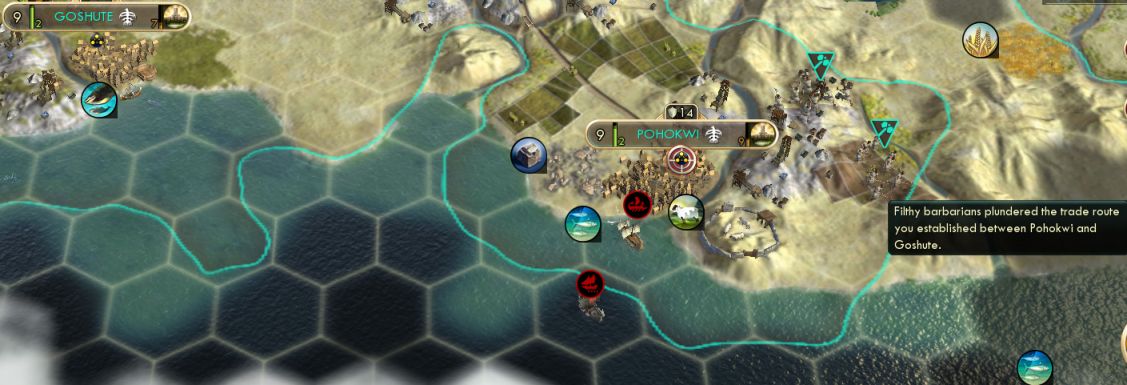
WTF happened here? Those ships were not visible last turn. Notice the closest fogged coastal square is 4 tiles away. It's impossible for that trireme to have moved 4 tiles and pillaged, but either it did so anyway, or somehow was allowed to spawn in a tile visible to me. And double-WTF is with that galley in the OCEAN tile? There's some screwed up bug here. Anyway, I lost THREE cargo ships to this bullshit before the cities could sink the barbs. Maybe it's a bit my own fault for not having a ship around to defend, but I had no reason to think that assault could happen. Not a huge deal in the end; the two coastal cities had been swapping food routes, but by now were well up the fat part of the growth curve, and the cargo ships could be rebuilt.
Anyway, I finished my universities around t122, twelve turns faster than the previous Shoshone game. Astronomy for the Renaissance also came at that time, and this game had more observatory mountains including at the capital. I was feeling good about this game, ahead in many areas, behind only in getting policies into Rationalism.
After Astronomy, the important tech goal was Printing Press to get the World Congress founded. I didn't go for this in some previous attempts, but I believe that getting Science Funding passed will make a major difference. That's how those 10th and 11th cities will be able to squeak out a Great Scientist before the game ends. Science Funding is tough to get passed thanks to some rough emergent AI behavior: they always hate it because they always have writers from the guild sooner and don't have university scientists until later. But I thought I could do it by smartly cycling my diplomats to as many AIs as possible, including moving my first one ahead of time to be in place as soon as the WC was founded.

Thirty turns later (taking the narrative a bit out of order), this worked, and I got my boost to Great Scientist production.
Next big question: Public Schools or Factories? Also unusually, I went for Industrialization first instead of Scientific Method. I never really noticed this, but you can get Industrialization noticeably sooner, it has two fewer Renaissance prerequisites and can be directly beelined. The Order ideology was very important here, for level-1 tenets for both GPP and happiness (Socialist Realism) which were both very tight. I had a good plan to enable the ideology: take a faith engineer to clock Big Ben, then buy 3 factories to open the ideology and Workers' Faculties, then build the rest of the factories. And the factories help build the public schools as well.

I'm never sure whether to report interesting moments that have nothing to do with the main narrative, but here's one. Unusually, I paid up the extra cost to acquire an AI's only copy of a resource. Because I desperately needed the happy: there were no available colosseum slots or affordable city-states with luxuries. But the real swing was those three WLKTDs and three other CS quests that paid off from acquiring the resource, so that was worth it.
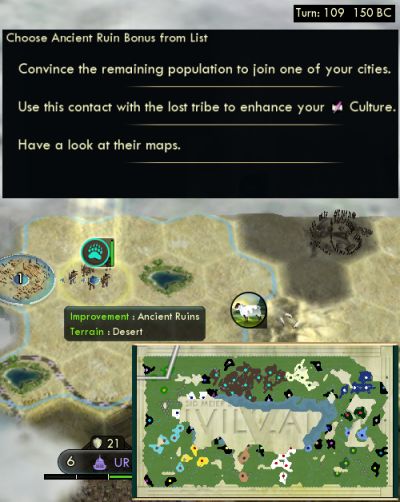 Haha, one more ruin in one last remote corner. Man, that's a pretty thin set of options. Tech is off because the ancient era is complete and classical techs aren't allowed. I don't know why barb camps are off the list, best guess is because there aren't any unrevealed ones nearby.
Haha, one more ruin in one last remote corner. Man, that's a pretty thin set of options. Tech is off because the ancient era is complete and classical techs aren't allowed. I don't know why barb camps are off the list, best guess is because there aren't any unrevealed ones nearby.
But I got a good payoff anyway in population. It still wouldn't go to the capital, but now the nearest side city would get a nice boost up to size 8!
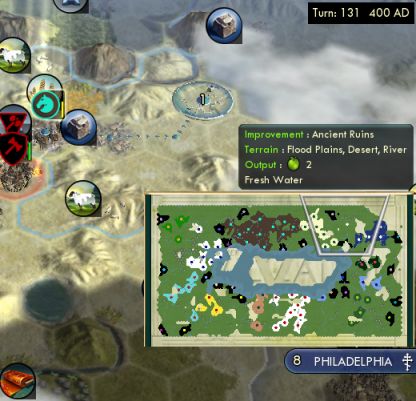 Are you freakin serious, another ruin on turn 131. I popped it and got barb camps? What the heck? Ha, right, only Pathfinders get to pick. Remembering that, I reloaded. Since it lasted this long, let's wait another 10 turns for a pathfinder to get here.
Are you freakin serious, another ruin on turn 131. I popped it and got barb camps? What the heck? Ha, right, only Pathfinders get to pick. Remembering that, I reloaded. Since it lasted this long, let's wait another 10 turns for a pathfinder to get here.
He did, and picked 75 gold.
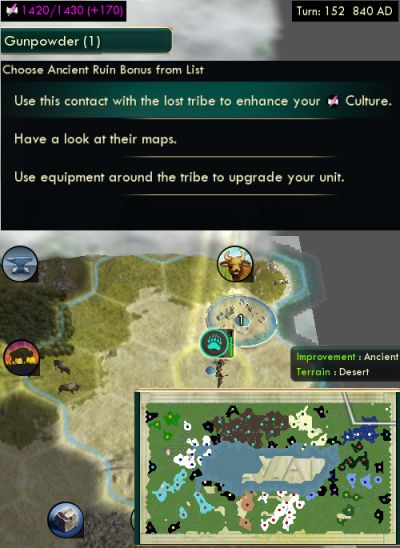 And ANOTHER one, galactically late in 840 AD! Man, I wish post-ancient technologies were possible, it would be a hoot to pop like Industrialization from one of these.
And ANOTHER one, galactically late in 840 AD! Man, I wish post-ancient technologies were possible, it would be a hoot to pop like Industrialization from one of these.
Anyway, that's again a remarkably thin list of available options. But check out the culture counter, that actually speeds this policy by a turn, what are the odds.
 That 20 culture even speeded the next policy a turn as well.
That 20 culture even speeded the next policy a turn as well.
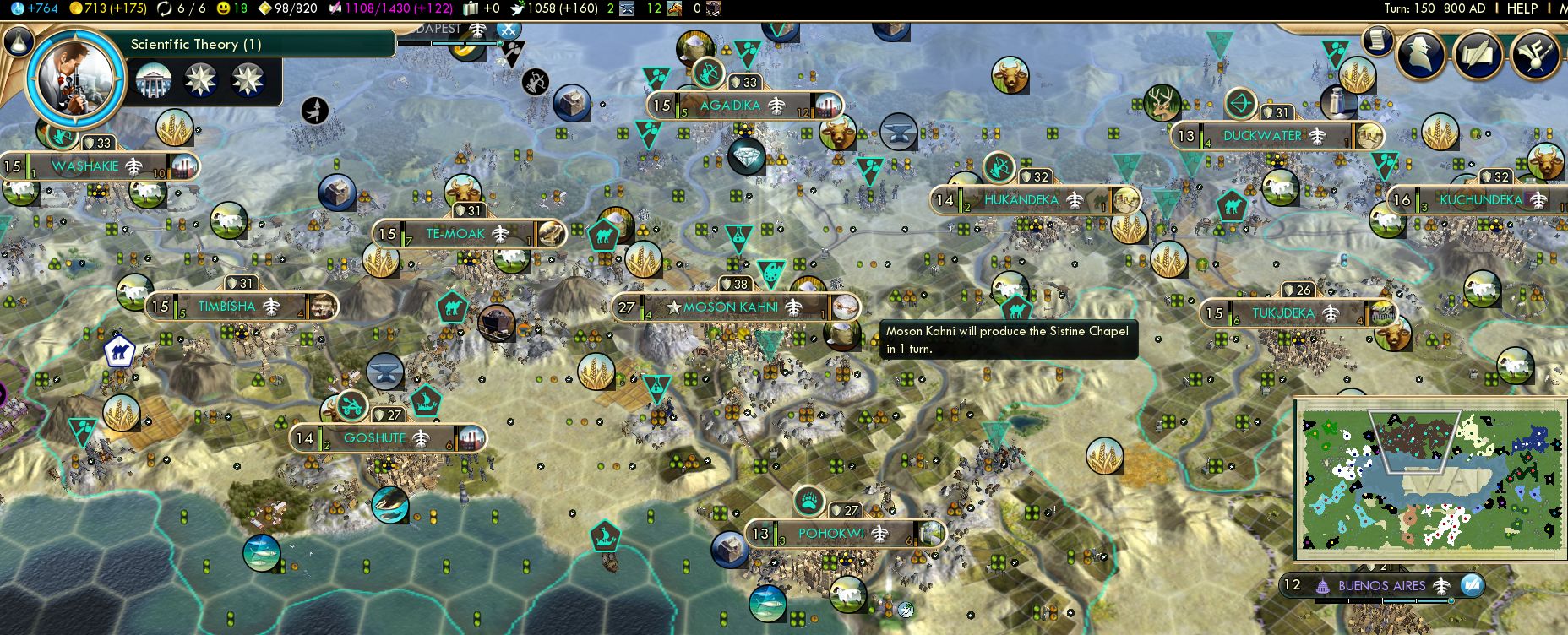
Here's the traditional turn 150 800 AD overview, just as we verge into public schools.
Just before this had come Industrialization. Good news, we had coal pre-mined so we could start on factories right away. Bad news, there was only ONE source of coal! I could only do 7 factories and would never get the last four. Cities that far down the pecking order would never do spaceship parts anyway, but it does hurt a bit to miss out on the 25% science from Workers' Faculties.
To get here involved ripping through Renaissance techs fast, at 2-3 turns each at 500 beakers/turn starting around turn 130. My previous Shoshone game took until around turn 160 to get up to that level of productivity. So things are still going pretty well.
One area that didn't go perfectly was policies. The sidetrack into Mercantilism was very much not optimal for pushing through both Rationalism and Order quickly. I was missing all of Humanism, Workers Faculties, Free Thought, and Skyscrapers for quite a bit longer than I wanted. Of them, Skyscrapers could come last, it was a want not a need until it was time to buy research labs. And culture was lagging pretty slowly, 20+ turns per policy for a while. But then it finally speeded up, thanks to multiplying together all at the same time Sistine Chapel, the Golden Age from the first great artist, and the industrial era value for cultured city-states (jumps from 12 to 26!). Incidentally, Pagodas synergize perfectly with Sistine Chapel, 2 monument culture + 2 pagoda culture perfectly reaches 4 to get the +25%.
- t124 Rationalism opener, via culture bulb from the first Great Writer
- t140 Secularism
- t152 Humanism
- t161 Free Thought (before Workers' Faculties because we were still busy building public schools before factories)
- t163 Workers' Faculties, via culture bulb from the second Great Writer
- t167 Skyscrapers, via culture bulb from Globe Theater
- t179 Sovereignty
- t182 Scientific Revolution and Rationalism finisher via Kremlin.
Note that this involved saving Great Writers #2 and #3 (one from Globe) for a while. They needed to wait until after 8 turns of the Sistine Chapel and first Golden Age to get up to full culture value.
And unfortunately, the other thing that didn't quite go right was Great Scientist production.
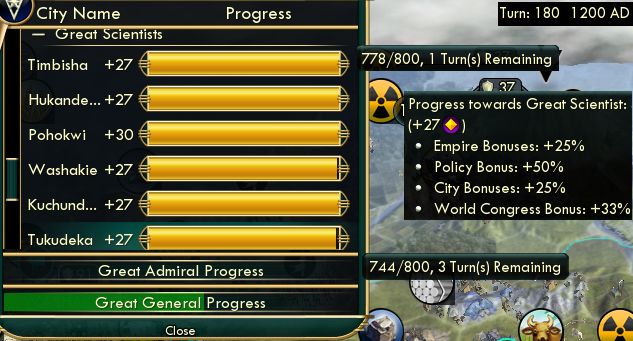
Here's what it looks like. All those cities are running just about in lockstep on Great Scientist points. Since they're all making 27 GPP/turn, they continually catch up to the cost counter and spawn a Great Scientist every four turns. But unfortunately, they wouldn't all outrace the end of the game. In fact, the 800 level here would be my last spawned scientist. Then I had to take the Porcelain Tower and Hubble Telescope, which drives the cost counter out of reach before the game ends. My original plan to get a Great Scientist from each of 11 cities just didn't work out. GPP numbers beyond 800 just take too long and there's no way to compress the elapsed time, nothing like starving for Caste System in Civ 4. Sciences Funding just comes too late. It had only been operating for 16 turns, at just 3 GPP/turn for each city (note that "+33%" gyps you by rounding: 12 + "33%" is 15.99 truncated to 15), less than one scientist worth of difference.
But even with a few scientists cut off, I ended up overshooting the tech tree anyway. This was the math: 7 scientists from cities + 4 from wonders (Pisa, Porcelain, 2x Hubble) + 3 from faith = 14 scientists. At 16k beakers each in the end game, that's 224,000 beakers.
Working backwards from the end of the tree, first assume that Particle Physics and Nanotechnology come for free via the Rationalism finisher and Oxford. Then the rest of the Information Era costs 72k beakers (6 techs * 12k beakers). The Atomic Era is 72k also (4 * 10k + 4 * 8k). The Modern era is 46k beakers (6500 * 4 + 5000 * 4). Total 190k beakers. I am already overshooting the end of the tech tree -- before public schools are even finished!
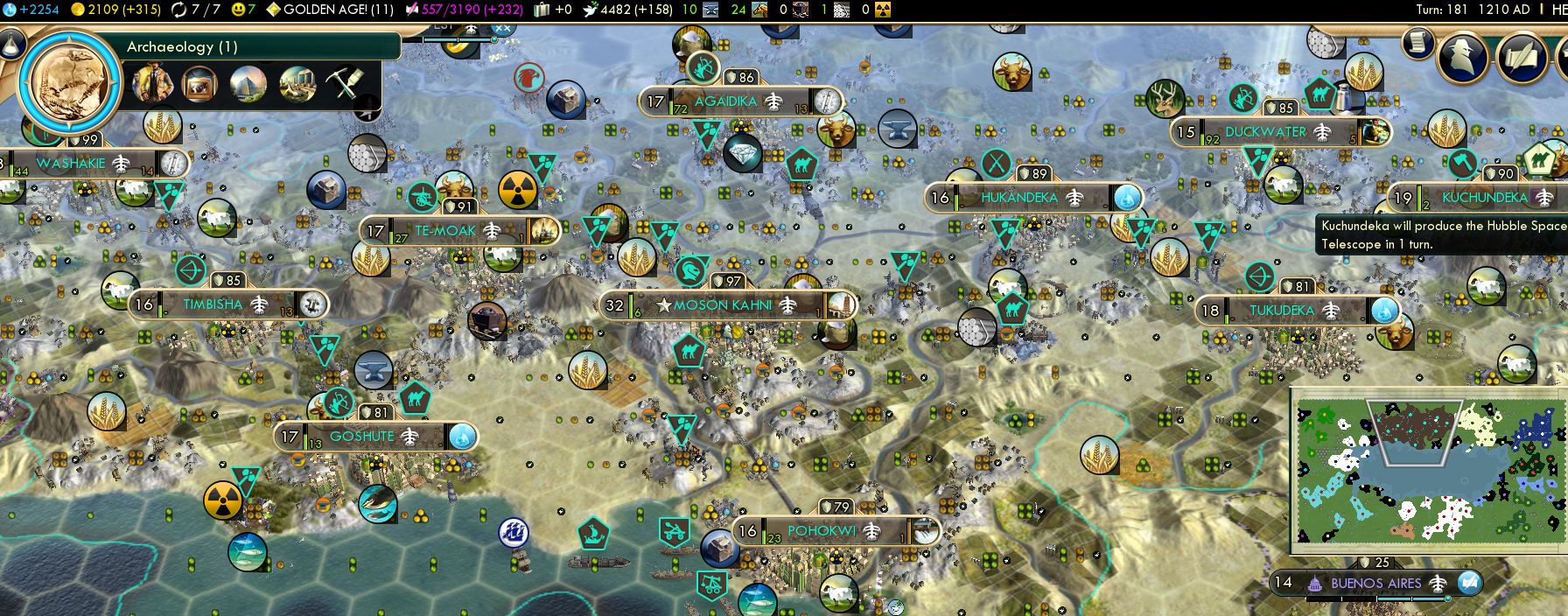
One last overview, as we start the spaceship parts. The end of a science game always involves 4-6 hours of micromanagement to get everything correct and make sure we waste no turns. I typically skip over this, but maybe it's worth relating for once here.
First, save money ahead of time to buy all the research labs ASAP on reaching Plastics. Ideally you will spend no money after public schools and save it all for r-labs. I did that well here, buying 10 of the 11 right away and the last a couple turns later. Make sure you get the Skyscrapers tenet in time for this.
Always bulb at least once to Plastics and once to Rocketry. Sometimes bulbing twice is correct. To gauge this, you must do the math on the number of scientists coming and their beakers so you will know if you will overrun the end of the tech tree. Here I already had the whole tree overshot, so did two bulbs to Rocketry.
Waiting until 8 turns after research labs gets you maximum value on the bulbing, of course. Getting to Rocketry quickly takes priority over that, but wait on the rest of the bulbs until those 8 turns pass. But then you are free to spend every bulb as soon as it's available. Beaker production is now maxed; cities should already be working all available Secularism specialists and all Free Thought trading posts, and should have no food to grow. Start Apollo Program immediately in your capital, of course.
You have to be careful about spending bulbs in order not to lose overflow truncation to the new cap in BNW of 5 turns worth of beakers. This involves jumping back and forth on the tech tree. Bulb a modern/atomic tech, then manually research the biggest older tech you can get in one turn (typically on the Navigation - Biology or Steel - Combustion lines) in order to burn off the overflow. I've developed a good eye for this; it's not difficult once you understand it, although it's hard to explain accurately.
The bulb targets, in order, are Satellites, Advanced Ballistics, and Robotics. Satellites to start on the Hubble Telescope, which you will rush with a Great Engineer bought with faith, but which will not quite provide enough hammers to finish it. Advanced Ballistics for the 3x SS Booster parts. Robotics for the SS Factories, and also to open up Nanotechnology so that you can claim that at the right time when a policy arrives for the Rationalism finisher. Usually I will reach all these techs right around when Apollo finishes.
These techs cover 5 of the 6 spaceship parts. Start building them all. Micromanage for hammers and buy SS factories and power plants in the weaker cities. If you will not reach your level-3 spaceship ideology (Spaceflight Pioneers or Space Procurements), do NOT use your capital for any of these earlier parts, save it for the last one.
You'll then finish all those SS parts in about 10 turns, while you finish bulbing up the top portion of the tree to Particle Physics. Claim PP itself with Oxford University. The last part should be rushed if possible via ideology, or if not, then build it in ~4 turns with an optimized capital. (Make sure to fire scientists in favor of engineers and all available hammer tiles.)
Purchasing: SS factories are the top target, of course. Then solar/nuclear plants in whatever cities are the long poles to the SS parts. Hydro plants can usually be built manually ahead of time (that is the only manual build necessary after factories, since you buy the research labs.) Buy a recycling center or two if necessary for aluminum. Any more spare money can go into windmills to eke out just a few more hammers.
That all is the optimal path, although I frequently stray from it on small details, particularly the Rationalism finisher can't always be conveniently timed.

The limiting factor turned out to be the non-capital SS parts. (Which therefore means Rocketry and Apollo came too late; should have spent one more bulb before that.) I optimized them all to complete on the same turn, though perhaps about three turns later than could have been achieved. Science Victory on exactly turn 190 1300 AD.
My fastest science victory in G&K came in 171 turns. I don't yet know if BNW times can beat that. I'm thinking not, between the lack of early-game cash sales and the tech cost penalty per city. But I'll try with at least a couple more.